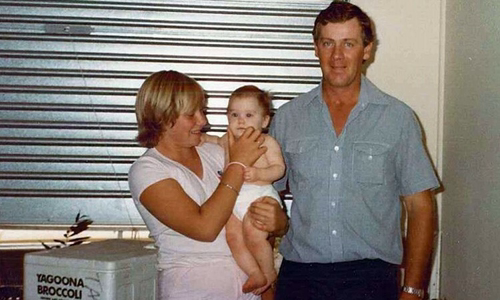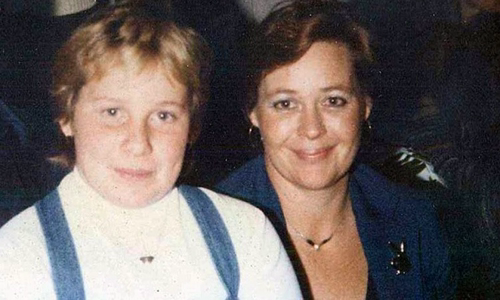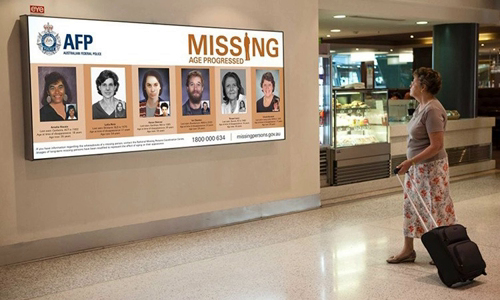Australia Ursula Barwick, 17, took a train in Tuggerah to Sydney and disappeared without a trace 30 years later.
One late spring day in 1987, when purple phoenix flowers began blooming, a worried man rushed to the Sydney police station in Australia to report his daughter Ursula Barwick missing.

Ursula Barwick (left) holds her younger half-sister, Kate, standing next to her father, Peter Barwick Photo: ABC News
At the time of disappearance, Ursula, a naive and easy-to-believe country girl, had just turned 17.
"She is a cheerful person," said Peter Barwick, Ursula's father. "Even in my dream, we never thought that the day when Ursula boarded the train to Sydney would be the last time I saw her."
Ursula was found only a few weeks after his disappearance, but that fact took 30 years for Peter to find out.
After Ursula disappeared, Peter took a picture of his daughter in his wallet, traveling everywhere to look for news, even dangerous and scary places like brothels in the Kings Cross area. "There, you will see so many people getting lost. It is sad to see that," Peter recalls looking for children.
A week, a month, and the whole year passed without any information about the girl, Peter felt that "something bad happened to me".
Why did an outgoing and friendly girl like Ursula disappear?
The people closest to Ursula describe her as lively, confident and always smiling. But from an early age, her life was a tragedy.
Ursula grew up in Quirindi, a small town of about 3,000 people in New South Wales (NSW). She was very close to her brother Lee Andrew, who died of a rare disease at age 8. Christopher, Ursula's younger brother, also died after birth. Ursula's parents' marriage broke up later and the little girl stayed with her mother, Cheree.
Mr. Peter remarried to Elizabeth and had two more children, Andrew and Kate. They move to the Central Coast, where Ursula comes to play every holiday. "The two kids really like her, and she loves them," Elizabeth said.
"I always had the feeling that everything in Ursula's life was about children," said Melissa Pouliot, Ursula's cousin.
When Ursula was in grade 10, Cheree decided to let her go to Sydney to experience the work of a babysitter. Flashy Sydney has everything her rural town doesn't have.
"That trip sucked her into thinking that this was where she wanted to go, work and stay in the city," Peter said. Returning, Ursula became rebellious and opposed her mother when she felt that life was constrained in the small town of Quirindi.
"He was really rebellious: drinking a lot of alcohol, hanging out at parties and not caring about everything that happened around him," recalls Melissa Donnelly, Ursula's classmate.
"Ursula learns to demand medicine, is in a bad relationship ... Bad rumors about her spread throughout the school and throughout the area," said Heidi Williams, Ursula's classmate.
Mrs. Cheree, not sure what to do with his rebellion, asked Peter to take her out of here for a while. At first, Ursula was happy to be with her two sisters, but then the relationship between her father and son became tense again. Peter was furious when he sent Ursula to Sydney one day but she voluntarily stayed a few more days.
"We had a heated argument. She said, 'You are 17, and you can leave the house and do whatever you like,'" Peter said.
Later, Ursula told his father that he had found a job in Sydney and wanted to go there. Not wanting the relationship to be more tense, Peter and Elizabeth agreed with my proposal.
"As parents, we have to accept the fact that we can't stop her. We thought we could at least contact and know her situation," Peter said.

Ursula Barwick (left) at age 11 and mother, Cheree Photo: ABC News
Bringing some cash from his father, Ursula boarded a train to Sydney in the middle of the week. Peter and Elizabeth plan to travel to the city that weekend to bring Ursula some personal belongings. She should have called home informing her new address, but they haven't received any news since then.
After Ursula's disappearance, Peter only knows how to immerse himself in work so that he does not have time to think of bad scenarios, such as the daughter who fell into the hands of a bad guy like Ivan Milat (the notorious serial killer. in Australia).
"I don't give myself time to think about the scary scene. After 8-10 years of hopeless search, we also give up hope that she is still alive," Peter said.
Over the years, the police occasionally called to say they were still investigating, but had never been to Ursula's relatives or friends to find information about the case.
Seventeen years after Ursula's disappearance, Cheree died of bone cancer but still did not know what happened to her only daughter.
Andrew, Ursula's younger brother, later became a police officer hoping to find his sister's whereabouts. When his colleague, Adam Marsh, was sent to the unit in charge of the disappearances, Andrew asked for information about Ursula.
"He said, 'If I have a chance, I will look for information to help you, but I don't expect much hope,'" Andrew said.
Years after that conversation, Ursula's case had hope. In 2010, the Australian Federal Police took the case to test new technology. The technology can use previous Ursula photos to build her face at age 40. This new image of Ursula was later posted on television and the airport, but to no avail.
When seeing the digital image of Ursula, old classmate Melissa felt worried because there were many wrong details. "The hair color and eye color in the picture is not like Ursula in real life. The day she disappeared also did not match," Melissa said.
She called the police hoping to correct the errors, but the police said they could not fix it until the case was reopened.
In 2014, detectives Kurt Hayward and Amy Scott were assigned to investigate the case of Ursula, as part of the NSW Police Force's efforts to solve disappearances across the state. For the first time in years, the police found Ursula's relatives and friends to get information.
Through the information provided, Hayward detective said that this is not a murder. Information about the investigation is constantly being updated by the police, leading Ursula's family to believe that they will get answers after years of hopeless searches.
In 2015, Ursula became the focus of the Lost Week in NSW campaign, which reminded Marsh, Andrew's former colleague, of a case five years ago. In 2010, when he was in the unit in charge of finding the missing person, Marsh had viewed a file about a girl in a car accident. He realized that this person had many similarities with Ursula, especially when looking at photos of the accident. However, this girl was named Jessica Pearce, and Marsh could not find any other information about this girl.
Marsh presented his remarks to his superiors and proposed to publish the case in the newspaper, but was rejected. Therefore, he did not mention this to the Barwick family.
But when he saw pictures of Ursula during the Missing Week campaign, he suddenly realized that Ursula was the accident girl in the file he had seen. "I felt a chill down my spine when I saw that Ursula's photos were identical to those of the girl in the accident," Marsh said.
Marsh talked to detectives Kurt Hayward and Amy Scott, who then showed photos of Jessica Pearce to Peter and Elizabeth.
"When I saw the first photo of the girl who had the accident, I was a bit scary," Peter said. "But looking closely, I realized that her eyes and mouth resembled Ursula."
After reviewing all the remaining photos, Peter confirmed this was Ursula. "The clothes that girl was wearing were exactly the same as Ursula's. My husband and I looked at each other and said, 'That's our Ursula,'" Peter said. "I can't accept that fact. All hope is gone. Everything is over. But what makes me feel most painful is that it happened just three weeks after she disappeared."

Images of 6 missing people, including Ursula (rightmost), were posted by Australian police in 2010 Photo: AFP
Finally, the Barwick family had the complete pieces of Ursula's last days. She went to Sydney but didn't have the job she said before. Instead of calling his parents, Ursula went to Kings Cross to play with a group of street children. She has a boyfriend named Mark, a young man from Melbourne.
"She was so naive and lovely compared to us. A real country girl," said Hans Tangen, a street kid in the group.
Ursula introduced herself as Jess, this was the name she intended to give to her daughter later, but did not expect it to be her name for 30 years.
On October 27, 1987, Ursula, Mark, Hans and another friend named Robert came together to Melbourne. Hans stole a car and drove to Yass. After that, Robert changed the steering and turned on the cruise control system. The high-speed launch vehicle crashed into a pickup.
The accident killed Ursula, Mark was unsuccessful buster, and Hans and Robert went to jail for stealing cars and dangerous driver lethal.
Ursula's body was taken to a morgue in Sydney, but no one came to take it. While the Barwick family frantically searched for the whereabouts of their daughter, the body of the girl named Jessica lay cold in Sydney's morgue for 15 months. Finally, she was buried at the Emu Plains cemetery in an unnamed grave.
The Sunday Telegraph reporter Ava Benny-Morrison said that the Ursula case had shown the limitations of police and government agencies involved in the search for the missing.
"The NSW Department of Health is responsible for the records of bodies in the morgue, while NSW police investigate disappearances based on their records. The two sides do not have a cross-exchange of records to match the case against each other, and this is the problem, "Benny-Morrison said.
The NSW Department of Health issued a statement saying it is working with state police to identify complex unresolved disappearances. There are about 2,600 missing people and 500 unidentified remains. However, current government efforts in this area have not been fruitful.
Forensic expert Jodie Ward proposed a search program for the missing people based on the DNA data of anonymous bodies and relatives of the missing.
"Through collating DNA data, we can help many families find relatives," Ward said.
An investigation into Ursula's accident was conducted last December. A second investigation into why the Ursula disappearance lasted for 30 years will also be opened next year.
In a statement, the NSW Police Force said it replaced the missing person search unit with another independent investigating unit to overcome the restrictions it encountered.
Earlier, the Barwick family had held a memorial service for Ursula at the Emu Plains cemetery, near the grave they thought was burying her. They could not accurately identify Ursula's tomb because archives at the time were very limited.
"We wanted to do things we couldn't do for her in 1987. That's what Peter wanted most. He just wanted her to have an official funeral," said Elizabeth, Ursula's stepmother.
Ursula's memorial was attended by more than 50 relatives and friends, as well as the police who participated in the investigation. "She was supposed to be a mother and have kids, but now she's nothing," Peter choked.
However, the Barwick family is probably still a bit luckier than the thousands of other missing families in Australia, when they finally got their answers after 30 years of searching.



 DanaSueVeach
DanaSueVeach







